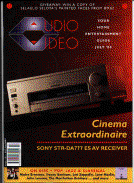
 Royd
The Doublet Review
Royd
The Doublet Review
Audio Video Magazine July 2000
 FOCUS/LOUDSPEAKERS FOCUS/LOUDSPEAKERS
ROYD DOUBLET Unlimited appeal PEAKS VERDICT Small and slim floorstanders look timid, but sound huge. Refinement and musicality score high marks, delivering source material with confident realism. Good slam up to medium volumes. Critical of ancillaries and recordings, though. PRICE R 7000.00 SUPPLIED BY Extraordinary AV (021) 704-2885. My review list noted delivery of a pair of floor-standing, British-made Royd loudspeakers. I expected something quite large, which meant some help with packing and unpacking the presumed monsters. When the Royd Doublets did arrive, only a single, not-so-heavy box contained two slim and quite unassuming floorstanders, finished in simulated black ash veneer. Yes, I was mildly disappointed, having though that a weekend of vintage rock would be a nice change from the eclectic jazz and ethereal classics I often use for reviews. Mounted on a neat, rounded plinth with three spikes, the Doublet stands just short of 900 mm tall, is 181 mm wide and a fairly shallow 161 mm deep. Low mounted gold-plated binding posts allow bi-wiring. More unusual are the twin 32 mm bass ports, which exit through the side panel in a mirror image arrangement. You either have both ports facing into the room (and at the other speaker) or towards the walls. The final choice requires some experimentation, and is very dependent on speaker location - I moved them well into the room, far away from side walls and corners, but with the bass ports firing outwards. Toeing them in allowed precise image focusing, but narrowed the soundstage to some extent, so I ended up facing them straight ahead. For all its plain-Jane appearance, the Doublet isnít just any old speaker. The team at Royd has done its homework well, with the accent on efficient operation, neutrality and transparent operation. Signal paths have been kept particularly clean, with only the simplest of crossovers, and no low-pass control for the mid/bass drivers. The three-driver complement consists of two identical 135 mm mid/bass drivers, constructed from with heavily impregnated paper cones on aluminium formers, mounted in a cast aluminium basket and driven by dual, high-power ceramic magnets. Unusual is the absence of a dust cap. These two drivers frame a centre-mounted soft-dome tweeter. The internal construction explains the two bass ports. The enclosure actually consists of three chambers. The two mid/bass drivers each operate in separate, single-vented chambers of roughly the same capacity, while the tweeterís chamber is completely sealed. Key specifications include an 89 dB sensitivity rating, a nominal 6 ohm impedance and a fairly optimistic 30 Hz to 20 kHz frequency response. Peak power handling capacity is 200 watts, but amplifiers delivering 25 watts or more should already be sufficient. Donít judge the Doublet at face value. Relative to its understated, compact experience, it provides the sonic goods with flair and enthusiasm. Thatís especially true of the staging, which can be almost holographic, while refusing to be restricted to physical room dimensions. The air-rich soundstage provides impressive scope for detail, especially since clarity is another strong talent of these floorstanders. They are able to dissect what would appear to be muddled or over-complex recordings when heard through other systems with a certain elegant assertiveness that peels away and serves up layers of information that would otherwise simply be glossed over. There is a negative side to this, of course - the Doublet is not particularly forgiving, and wonít shirk its responsibility to point out shortcomings in source components or recordings. On the other hand, a fine CD such as the Pat Metheny Bandís Imaginary Day is presented in every glorious, lush detail, on a stage that provides full scope for the inventive instrumentation. Pace and punch rivals much larger speakers, too - perhaps 30 Hz is not that optimistic, after all. The bass has thrust and presence, although their composure will start getting a little fuzzy at the edges at very high listening levels. But then, these arenít meant to be party boom boxes. Texture, rich tonal hues and the full emotional content of a recording are accurately and fluidly explored by the Royds, and their musical integrity is never questioned. That they are able to communicate so intimately with the listener is a measure of excellence often missing from speakers costing substantially more. I thoroughly enjoyed the Royds, not only for their ability to translate music with unwavering truthfulness, and their boundless staging and presence, but also because they provided an objective, trustworthy performance that made judging the contribution of each component in the system chain that much easier. As such, this would be an ideal reference speaker, capable of placing even high-end components under a fair but critical spotlight. That they still involve and entertain in the process, makes the Royd Doublets one of those classic speakers that should enjoy enduring popularity among discerning music listeners and audio enthusiasts alike. Deon Schoeman
|